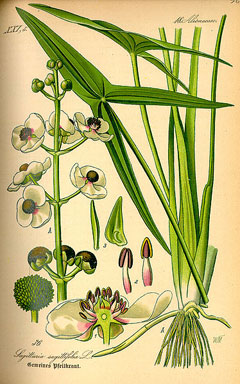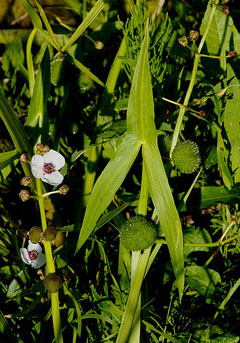 |
|
|
 |
| http://commons.wikimedia.org/wiki/User:Fice |
Translate this page:
Summary
Sagittaria sagittifolia (commonly "Arrowhead") is a flowering wetland perennial native to temperate Europe and Asia. It commonly grows in standing, or slow-moving water, 10-50 cm deep. Arrow-shaped leaves are produced at the terminal end of a petiole up to 45 cm long. Edible starchy tubers are found at the base of long, slender roots in the fall, as leaves die back. A similar plant, Sagittaria latifolia, is common to the west coast of North America, and can be used in the same manner.
Physical Characteristics

 Sagittaria sagittifolia is a PERENNIAL growing to 1 m (3ft 3in) by 0.5 m (1ft 8in).
Sagittaria sagittifolia is a PERENNIAL growing to 1 m (3ft 3in) by 0.5 m (1ft 8in).
See above for USDA hardiness. It is hardy to UK zone 7 and is not frost tender. It is in flower from July to August, and the seeds ripen from August to September. The species is monoecious (individual flowers are either male or female, but both sexes can be found on the same plant) and is pollinated by Insects.
Suitable for: light (sandy), medium (loamy) and heavy (clay) soils. Suitable pH: mildly acid, neutral and basic (mildly alkaline) soils. It cannot grow in the shade. It prefers wet soil and can grow in water.
UK Hardiness Map
US Hardiness Map
Synonyms
Sagittaria japonica.
Plant Habitats
Pond; Bog Garden;
Edible Uses
Edible Parts: Leaves Root
Edible Uses:
Root - cooked[2, 4, 13, 56]. Excellent when roasted, the taste is somewhat like potatoes. The tubers are starchy with a distinct flavour[116]. The tubers should not be eaten raw[200].The skin is rather bitter and is best removed after the tubers have been cooked[183]. Tubers can also be dried and ground into a powder, this powder can be used as a gruel etc or be added to cereal flours and used in making bread[55, 94].The roots (tubers really) are borne on the ends of slender roots, often 30cm deep in the soil and some distance from the parent plant. The tubers of wild plants are about 15cm in diameter and are best harvested in the late summer as the leaves die down. The dried root contains (per 100g) 364 calories, 17g protein, 1g fat, 76.2g carbohydrate, 3.1g fibre, 5.8g ash, 44mg calcium, 561mg phosphorus, 8.8mg iron, 2,480mg potassium, 0.54mg thiamine, 0.14mg riboflavin, 4.76mg niacin and 17mg ascorbic acid. They contain no carotene[218]. Leaves and young stems - cooked[183]. Somewhat acrid.
References More on Edible Uses
Medicinal Uses
Plants For A Future can not take any responsibility for any adverse effects from the use of plants. Always seek advice from a professional before using a plant medicinally.
Antiscorbutic Diuretic Galactofuge
The plant is antiscorbutic, diuretic[4]. The leaf is used to treat a variety of skin problems[218]. The tuber is discutient, galactofuge and may induce premature birth[218].
References More on Medicinal Uses
The Bookshop: Edible Plant Books
Our Latest books on Perennial Plants For Food Forests and Permaculture Gardens in paperback or digital formats.

Edible Tropical Plants
Food Forest Plants for Hotter Conditions: 250+ Plants For Tropical Food Forests & Permaculture Gardens.
More

Edible Temperate Plants
Plants for Your Food Forest: 500 Plants for Temperate Food Forests & Permaculture Gardens.
More

More Books
PFAF have eight books available in paperback and digital formats. Browse the shop for more information.
Shop Now
Other Uses
References More on Other Uses
Cultivation details
A pond or bog garden plant, it requires a moist or wet loamy soil in a sunny position[1]. Prefers shallow, still or slowly flowing water up to 30 - 60cm deep[200]. Plants are fairly cold tolerant, surviving temperatures down to at least -10°c, though the top growth is damaged once temperatures fall below zero. They grow best in warm weather and require at least a six month growing season in order to produce a crop[206]. A polymorphic species, the sub-species S. sagittifolia leucopetala is extensively cultivated for its edible bulb in China where there are many named varieties[2, 56, 61].
References Carbon Farming Information and Carbon Sequestration Information
Temperature Converter
Type a value in the Celsius field to convert the value to Fahrenheit:
Fahrenheit:
The PFAF Bookshop
Plants For A Future have a number of books available in paperback and digital form. Book titles include Edible Plants, Edible Perennials, Edible Trees,Edible Shrubs, Woodland Gardening, and Temperate Food Forest Plants. Our new book is Food Forest Plants For Hotter Conditions (Tropical and Sub-Tropical).
Shop Now
Plant Propagation
Seed - best sown as soon as it is ripe in a pot standing in about 5cm of water. Prick out the seedlings into individual pots when they are large enough to handle, and gradually increase the depth of water as the plants grow until it is about 5cm above the top of the pot. Plant out in late spring or early summer of the following year. Division of the tubers in spring or autumn. Easy. Runners potted up at any time in the growing season.
Other Names
If available other names are mentioned here
Native Range
TEMPERATE ASIA: Lebanon, Turkey, Russian Federation-Ciscaucasia (Ciscaucasia), Armenia, Azerbaijan, Russian Federation-Western Siberia (Western Siberia), Russian Federation-Eastern Siberia (Eastern Siberia (west)), China (Xinjiang Uygur Zizhiqu) EUROPE: Denmark, Finland, United Kingdom, Ireland, Norway, Sweden, Austria, Belgium, Switzerland, Czech Republic, Germany, Hungary, Netherlands, Poland, Slovakia, Russian Federation (European part), Belarus, Estonia, Lithuania, Latvia, Moldova, Russian Federation (Kalmykija, Respublika, Astrakhan, Saratov, Volgogradskaja oblast), Ukraine (incl. Krym), Albania, Bulgaria, Bosnia and Herzegovina, Greece, Croatia, Italy (incl. Sardinia), Montenegro, Romania, Serbia, Slovenia, Spain, France, Portugal
Weed Potential
Right plant wrong place. We are currently updating this section.
Please note that a plant may be invasive in one area but may not in your area so it's worth checking.
Conservation Status
IUCN Red List of Threatened Plants Status :

Growth: S = slow M = medium F = fast. Soil: L = light (sandy) M = medium H = heavy (clay). pH: A = acid N = neutral B = basic (alkaline). Shade: F = full shade S = semi-shade N = no shade. Moisture: D = dry M = Moist We = wet Wa = water.
Now available:
Food Forest Plants for Mediterranean Conditions
350+ Perennial Plants For Mediterranean and Drier Food Forests and Permaculture Gardens.
[Paperback and eBook]
This is the third in Plants For A Future's series of plant guides for food forests tailored to
specific climate zones. Following volumes on temperate and tropical ecosystems, this book focuses
on species suited to Mediterranean conditions—regions with hot, dry summers and cool, wet winters,
often facing the added challenge of climate change.
Read More
Expert comment
Author
L.
Botanical References
17200
Links / References
For a list of references used on this page please go here
Readers comment
| Add a comment |
|
If you have important information about this plant that may help other users please add a comment or link below. Only comments or links that are felt to be directly relevant to a plant will be included. If you think a comment/link or information contained on this page is inaccurate or misleading we would welcome your feedback at [email protected]. If you have questions about a plant please use the Forum on this website as we do not have the resources to answer questions ourselves.
* Please note: the comments by website users are not necessarily those held by PFAF and may give misleading or inaccurate information.
To leave a comment please Register or login here All comments need to be approved so will not appear immediately.
|
Subject : Sagittaria sagittifolia
|
|
|
|